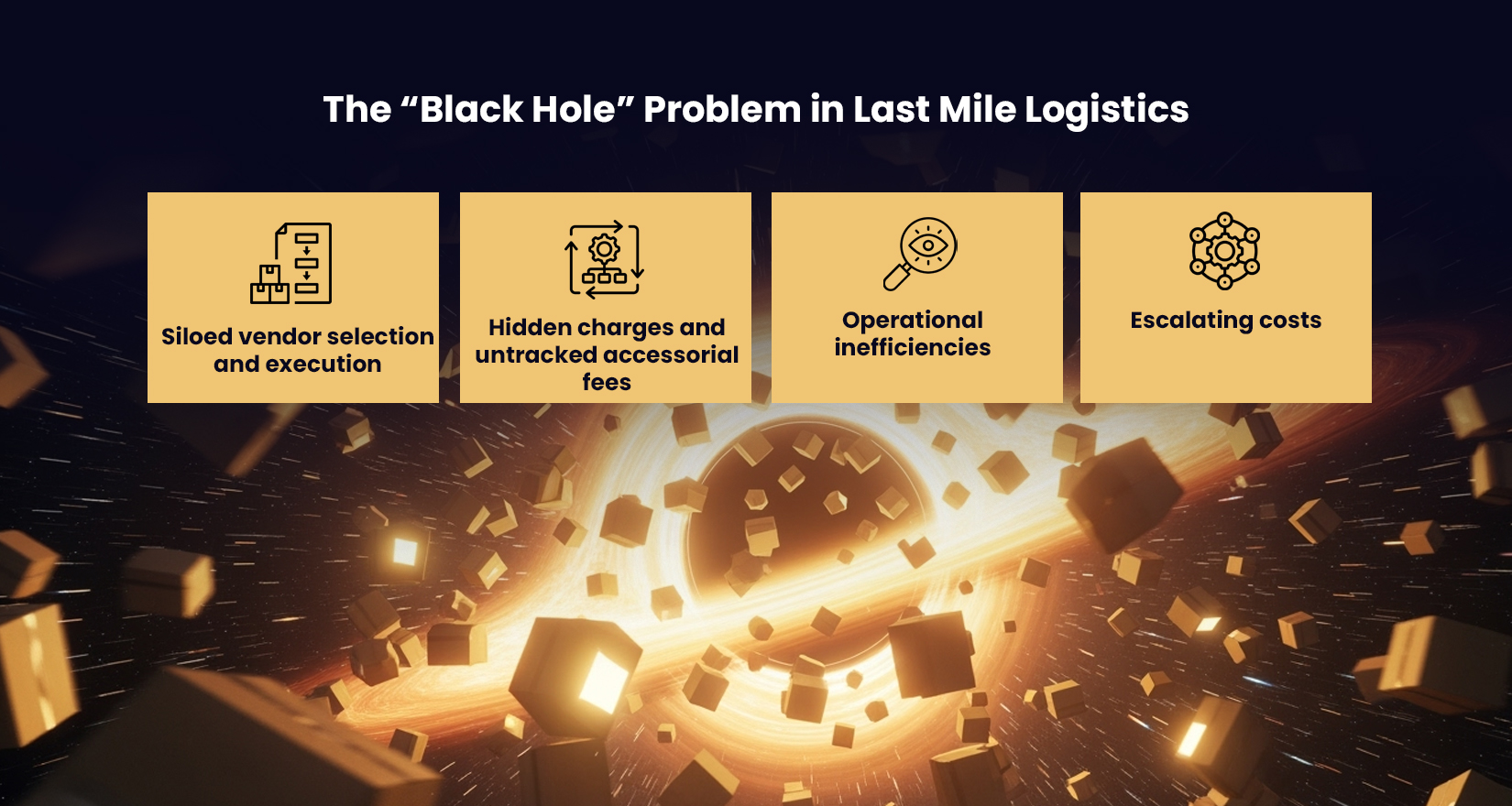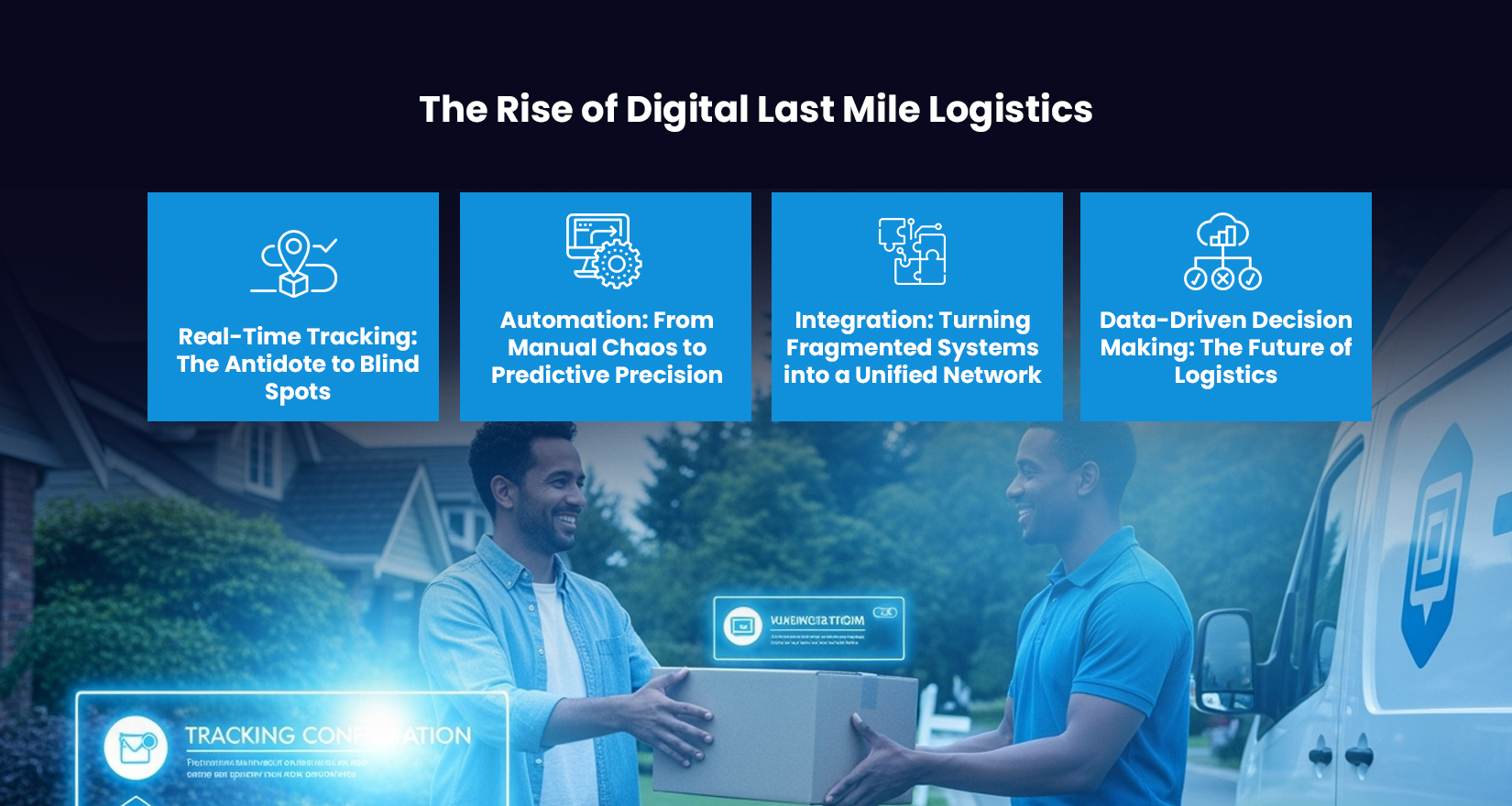
How to Avoid the Last Mile Black Hole
Over the five years that have passed since the pandemic, the world has experienced a crash course in supply chain fragility. Every disturbance in the supply chain has reminded logistics leaders of one uncomfortable reality. The first and last mile are the weakest links. The first mile will lay the foundation, but the last mile logistics segment that often becomes a black hole of inefficiency, opacity, and escalating costs.
The “Black Hole” Problem in Last Mile Logistics

The term “landside container black hole” in logistics refers to the disappointing reality of losing visibility into the movement of cargo. From the moment it leaves the port and is then in domestic transportation. When this visibility is lost, freight forwarders and shippers are confronted with any number of blind spots. Such as delivery milestones, cost management, and carrier performance. This leads to increased chances of missing on-time delivery, increased operating costs, and unhappy customers.
Despite its significance the first and last mile of any shipment journey is poorly connected and remains largely manual. The shocking part of all of this? The first and last mile account for up to 53% of total shipment costs, a research by McKinsey & Company. That is a ton of value lost in an area often treated as an afterthought.
Everything is often managed by separate local teams who have knowledge specifically to the port but not within the context of the global logistics network. Decision-making is more decentralized and ad hoc, finding ties to personal relationships rather than performance. This is not based on strategy; thisisbased on a form of survival.
For multinational logistics providers, this siloed approach carries a heavy price. Disjointed systems lead to:
1. Siloed Vendor Selection and Execution:
Limited visibility and separate software systems make it less likely for carrier operations to be consolidated or for shipment volumes to be combined to save money. Logistics providers miss the chance to negotiate volume-based pricing in an efficient and cost-saving manner. Thereby, forcing transportation spending higher as a result.
2. Hidden Charges and Untracked Accessorial Fees:
The inability to see real-time visibility into billing and costs allows accessorial fees and hidden costs to creep in without notice. After a while, these costs will go unnoticed and will ultimately reduce profit margins and skew shipment profitability.
3. Operational Inefficiencies:
Emails, spreadsheets, and phone calls for coordination yield longer response times for decisions, opportunities, and communication. Using resources to coordinate compared to analyzing data, costs, and decision. This leads to making slows process times, reduces productivity, and draws teams away from strategic work that creates value.
4. Escalating Costs:
Management of drayage coupled with the cost of waiting and problem-solving takes away valuable resources and increases operating expenses. Without automating this activity, or working off data-based decision-making process, the logistics provider will spend more time in inefficient processes. This leads to waste time and inflate expense costs leading to long-term sustainability and company performance.
With 94% of shippers saying visibility is a top priority, gaps in visibility are no longer tolerable. One thing is clear with the industry’s shift to digital transformation: in order to avoid the last mile black hole, websites and software can’t be treated as “quick fixes”. And the state of visibility requires integrated smart technology.
The Rise of Digital Last Mile Logistics

The digital freight forwarding industry is predicted to grow by more than 25% CAGR through 2030, based on a collective necessity for visibility and efficiency in operations. Well, the answer here is raised at last mile logistics entirely harnessing hope, visibility, automation, and analytics with greater integration.
Okay, let’s unpack a little more about what constitutes an effective solution in the last mile warehouse delivery space.
1. Real-Time Tracking: The Antidote to Blind Spots
Real time visibility via GPS, IoT, telematics is no longer a luxury, it is required. Using these elements, the freight forwarder can track the position and disposition of every container or shipment from the port gate to the final delivery point.
This anticipatory visibility leads to:
– Proactive exception management meaning the team can reign in a delay before it becomes a delay. And rightly articulate an alternative option to the customer.
– Predictive insight into optimal routes, and delivery windows times.
– Customer transparency, which means live ETA updates, improving trust and flow of reliability.
If the freight forwarder and customer simply embrace and invest in last mile software with proactive visibility, freight forwarders can begin to escape the “where’s my shipment” nightmare that has been associated with the industry for some decades.
2. Automation: From Manual Chaos to Predictive Precision
Automation, driven by AI and machine learning, is transforming how logistics teams plan for, assign, and execute deliveries. AI-enabled last mile logistics software can process multiple variables, such as traffic patterns, weather, and the density of parcels being delivered. This can help to create the most efficient route in real-time.
Not only does this reduce costs, it improves fuel efficiency, decreases idle time, and lowers environmental impact. A recent study by Gartner, on average, AI-based routing solutions reduce overall delivery costs by 20%. While increasing on-time performance by 30%.
Automation also reduces repetitive daily operational mundane tasks such as driver assignment, proof of delivery checks, and reporting anomalies. This allows them to focus on strategic decisions rather than on dealing with daily operational issues.
3. Integration: Turning Fragmented Systems into a Unified Network
A true last mile logistics solution does not operate in a silo but instead, it integrates with transportation management systems (TMS), warehouse management systems, and enterprise resource planning (ERP). The interoperability of these systems allows teams to make better decisions on carrier selection, load optimization, and freight costs.
When they are properly integrated, it provides logistics teams with:
– Transparency into visibility throughout all stages of shipment.
– Centralized dashboards for vendor and carrier performance.
– Automation to alert for SLA exceptions, or delivery anomalies.
The net result is overall improved control, responsiveness, and a potential for measurable cost minimization.
4. Data-Driven Decision Making: The Future of Logistics
The logistics landscape is now driven by data, not instinct. Last mile logistics software collects large amounts of data that can be turned into actionable insights.
With analytics dashboards and AI forecasting, logistics managers can now pinpoint top carriers, predict delays, and have a more accurate view of how to plan capacity. In a world of uncertainty, adaptability is gold.
We see companies who have taken on advanced last mile delivery solutions report 35% improved delivery accuracy and 40% reduced operational costs. Thereby, suggesting that digital transformation is not hype, but ROI in action.
The Road Ahead: From Black Hole to Bright Future
The last mile black hole is not a lasting issue; it is a byproduct of outdated processes and disconnected visibility. As the logistics ecosystem becomes increasingly intricate, success will rely on predicting, adjusting, and delivering with precision. It’s time to retire the spreadsheets and engage smart, connected software for last mile logistics.
By leveraging automation, AI, and real-time visibility capabilities, companies can transform the last mile from a cost center to a growth engine with quicker deliveries, lower costs, and a transparent, data-driven enterprise built for the future of global logistics.
Conclusion
The last mile is short, but its influence is substantial. Closing visibility gaps with a verified last mile solution means companies can lower costs, improve reliability, and deliver an enhanced customer experience. In the fast-moving logistics landscape of today, smarter operations are not a choice; they are necessary to survive and scale.
Discover how LogiNext’s last mile delivery solution enables businesses with complete visibility, intelligent automation, and performance-based logistics management. Ensuring clarity every mile of the way that matters. Because in logistics, the companies that can see the furthest, move the fastest. So click on the red button and book a demo today!
25







@LogiNext